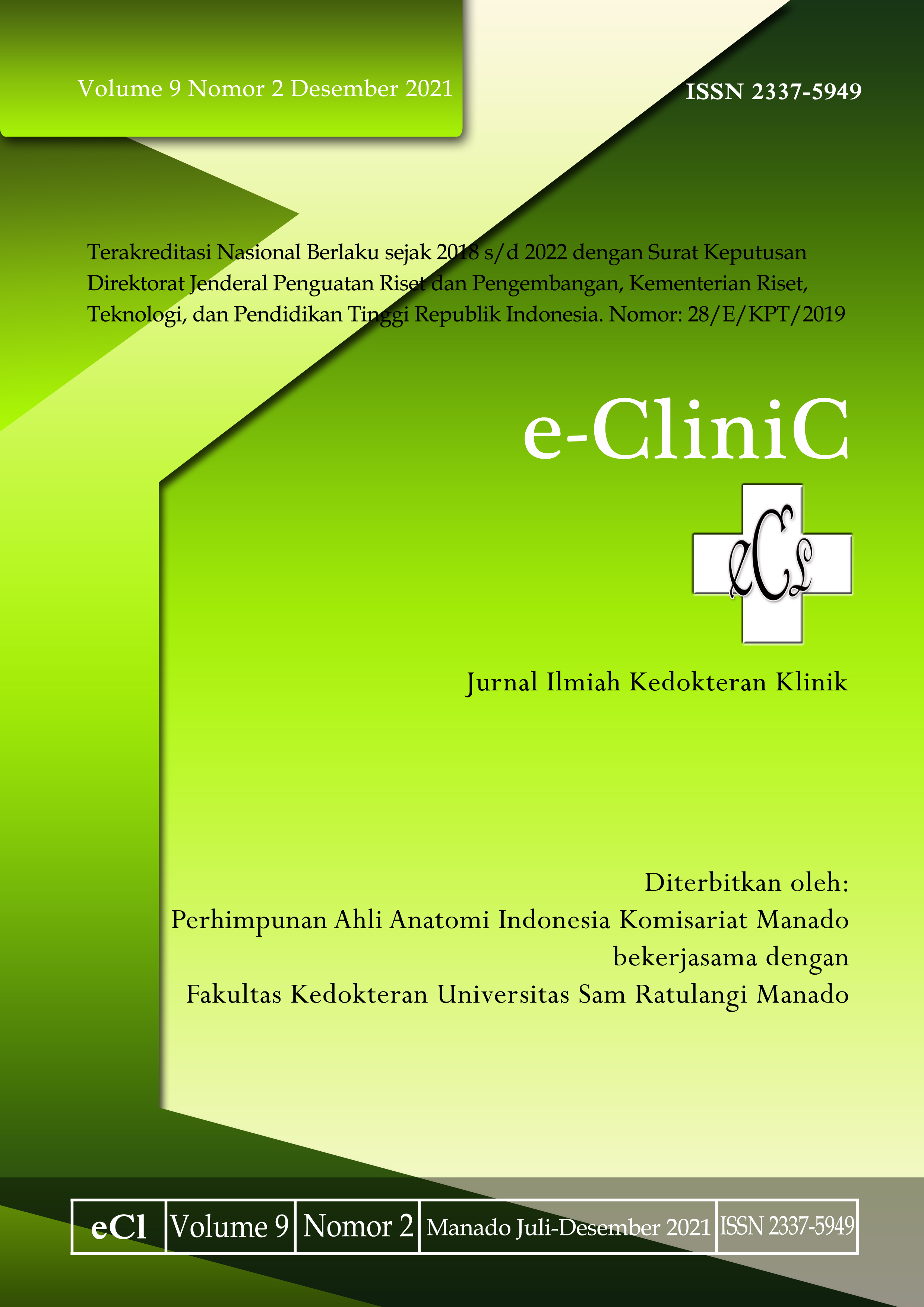Karakteristik Pasien Age-related Macular Degeneration (AMD) pada Fasilitas Kesehatan Tersier di Masa Pandemi Covid 19
DOI:
https://doi.org/10.35790/ecl.v9i2.35645Abstract
Abstract: Age-related macular degeneration (AMD) is a neurodegenerative disease that affects the macula and is characterized by age-related loss of the central visual field. AMD contributes greatly to blindness for people over 50 years old in the world. The prevalence of AMD is increasing from year to year. Albeit, during the Covid-19 pandemic the number of patient visits to health facilities tends to decrease. This study was aimed to report the clinical characteristics of patients with AMD in tertiary health facilities during the covid 19 pandemic and to compare them with previous reports. This was a retrospective and descriptive study using medical record data of the Ophthalmology Clinic of Prof. Dr. R. D. Kandou Hospital Manado from March 2020 to June 2021. There were 12 patients in this study consisting of 10 males and two females. Age range of 56-75 years had the highest percentage (58%). The non-neovascular subtype were found in 7 patients (58.3%) meanwhile the neovascular type in 5 patients (41.7%). The identified risks were hypertension (50%), diabetes mellitus (DM) (8.3%), and DM associated with hypertension (16,7%), meanwhile no risk factor was found in 8.3% of patients. The number of patient visits decreased in the study period compared to previous reports conducted before the pandemic. In conclusion, the majority of AMD patients were male, age group of 56-75 years, and had non-neovascular subtype. The identified risk factors were hypertension and diabetes mellitus.
Keywords: age related macular degeneration (AMD); characteristics of patients
Â
Abstrak: Age-related macular degeneration (AMD) adalah penyakit neourodegeneratif yang mengenai bagian makula dan ditandai dengan hilangnya lapang pandang sentral yang berhu-bungan dengan usia. AMD berkontribusi besar terhadap angka kebutaan untuk usia di atas 50 tahun di dunia. Prevalensi AMD pun semakin meningkat dari tahun ketahun. Pandemi Covid 19 diketahui mengurangi angka kunjungan pasien ke fasilitas kesehatan. Penelitian ini bertujuan untuk melaporkan karakteristik klinik pada pasien AMD pada fasilitas kesehatan tersier di masa pandemi covid 19 dan membandingkannya dengan laporan sebelumya. Jenis penelitian ialah deskriptif retrospektif dengan menggunakan data rekam medik di Poliklinik Mata RSUP Prof. Dr. R. D. Kandou Manado periode Maret 2020-Juni 2021. Hasil penelitian mendapatkan sebanyak 12 pasien AMD; sebagian besar berjenis kelamin laki-laki (83,3%), berada dalam rentang usia 56-75 tahun (58%), dengan subtipe AMD non neovaskular (58,3%). Faktor risiko yang teridentifikasi ialah hipertensi (50%), diabetes melitus (DM) (8,3%), dan DM disertai hipertensi (16,7%), sedangkan yang tanpa faktor risiko hanya 8,3%. Jumlah kunjungan pasien berkurang di periode waktu penelitian dibandingkan dengan laporan yang dilakukan sebelum masa pandemi. Simpulan penelitian ialah mayoritas pasien AMD berjenis kelamin laki-laki, usia 56-75 tahun, dengan subtipe non neovaskular. Faktor risiko teridentifikasi ialah hipertensi dan diabetes melitus.
Kata kunci: age-related macular degeneration (AMD); karakteristik pasien
Downloads
Published
How to Cite
Issue
Section
License
COPYRIGHT
Authors who publish with this journal agree to the following terms:
Authors hold their copyright and grant this journal the privilege of first publication, with the work simultaneously licensed under a Creative Commons Attribution License that permits others to impart the work with an acknowledgment of the work's origin and initial publication by this journal.
Authors can enter into separate or additional contractual arrangements for the non-exclusive distribution of the journal's published version of the work (for example, post it to an institutional repository or publish it in a book), with an acknowledgment of its underlying publication in this journal.
Authors are permitted and encouraged to post their work online (for example, in institutional repositories or on their website) as it can lead to productive exchanges, as well as earlier and greater citation of the published work (See The Effect of Open Access).







